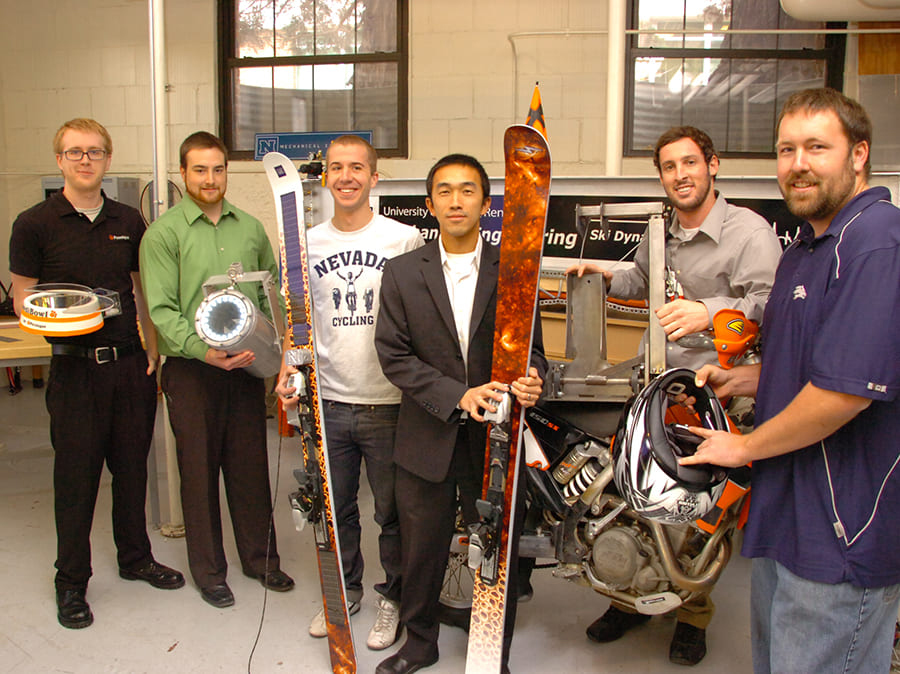What’s on your Christmas list? Solar-powered music in your motorcycle helmet, a radio frequency-controlled food dish for Fido or a high-performance ski built with nanomaterials in the core and solar panels on the tops to power your electronic devices while skiing?
While shoppers won’t find them in stores, yet, these are just a few of the inventions students in a mechanical engineering class have designed and built for their class project. The class, Systems Design, integrates new ideas and materials (including nanomaterials) into the inventions. Other inventions include a robot delivery system built for Amazon’s Fernley, Nev. shipping plant, a wheelchair-mounted camera-assist system with a chin controller, a portable mini-turbine to drop into a river to generate power for electronic equipment while backpacking and an innovative dirt bike carrier for a pickup truck.
“The student teams have really amazed me with their concepts, designs and finished products,” Kam Leang, assistant professor in the mechanical engineering department at the University of Nevada, Reno said. “We’ve had great success with some community business partners in applying the concepts and designs into the real world.
“Amazon.com plans to save money in their distribution center using the student-developed robotic delivery system, G.E. will save money using an energy-harvesting device incorporated into large motors at their facilities and at Ibarra, Inc. in Sparks there’s great promise for a tank inspection system one of our teams developed to inspect pipes and tanks in Ibarra’s global market.”
The new NanoWatt skis, built on the ski press designed and constructed by Leang and his students, incorporates nanomaterials in the core to dampen vibration and make the ski stable at all speeds in all snow conditions. Additionally, the team embedded solar panels on the top of the skis to charge batteries and power electronic devices such as a GPS or radio transmitter/receiver. It’s the second year the class has developed innovative skis.
The class is designed as part of a new Energy Efficient Systems and Dynamic Structures mechanical engineering curriculum made possible through a $200,000 grant from the National Science Foundation’s Nanotechnology Undergraduate Education in Engineering Program.
To develop the new curriculum, Leang is working closely with fellow mechanical engineering department member Jonghwan Suhr, who is a co-principal investigator and nanomaterials expert, as well as with John Cannon, co-principal investigator and a faculty member in the University’s education department.
The students looked for real-life challenges and solutions in choosing their class projects. With more than one pet in the house, one may dominate the food bowl, so a student team developed “The Incredibowl,” which opens and closes with a radio frequency-controlled collar, so only one pet can eat from the bowl, one of the students was tired of wrestling with his dirt bike when loading it into his pickup truck so he designed and built the motorcycle mount for the truck bed that makes it easy for just one person to load and secure the motorcycle.
The curriculum is designed to encourage practical, easy-to-relate-to macro-scale applications such as aerospace structures and wind-energy turbine blades, which will also be introduced into sophomore- and junior-level courses. The technical engineering challenges and need for improving functionality of all of these applications are presented and then linked to solutions offered by nanotechnology.
“I’m developing the teaching modules for dissemination to other universities, such as in Vermont, Colorado, Utah and other ski towns with engineering programs nearby,” Leang said. “I envision a competition like the annual concrete canoe races where we will all design and manufacture our skis under a set of rigorous yet creative parameters and then race them. It could be as early as this spring.”
















